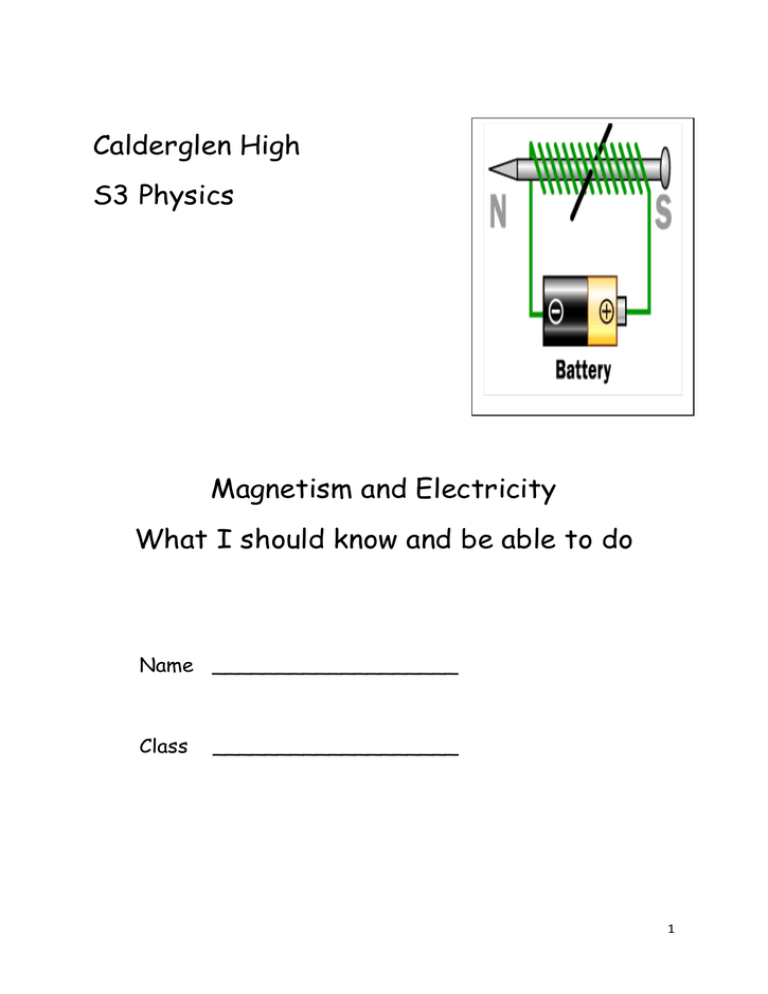Calderglen High S3 Physics Magnetism and Electricity What I
advertisement

Calderglen High S3 Physics Magnetism and Electricity What I should know and be able to do Name ___________________ Class ___________________ 1 What I Should Know Magnetism Magnetism is an invisible force that will act at a distance Magnets attract MAGNETIC material such as iron, nickel and cobalt. An invisible magnetic field exists around a magnet. An electromagnet is a coil of wire wound on an iron core An electromagnet becomes a magnet when a current flows through the coil The strength of the electromagnet depends upon: The number of turns Current in the coil Length of Coil I can state uses of electromagnets. e.g. door bell, electric motor I can explain how an electric motor works Coil of wire between two permanent magnets Current flows in the coil through brushes Coil rotates due to interaction of permanent magnetic field and the coils electromagnetic field Electrostatics I know the structure of the atom Particle Charge Proton Positive Electron Negative Neutron Neutral Location Nucleus Orbit around nucleus Nucleus Atoms are electrically neutral because: Number of Positive Protons = Number of Negative Electrons Charge is built up when electrons are transferred between one substance and another by rubbing 2 What I Should Know An electric field is a region in which a charge experiences a force. A Van De Graaff dome becomes positively charged when a rubber belt removes electrons A spark is seen when a metal sphere is brought close to the dome. This is because negative charge moves through the field to the dome. I can complete electric field diagrams Current Electricity Current is the movement of electrical charge around a circuit Conductors allow current to pass through because there are free moving electrons. Metals are good conductors of electricity Insulators do not allow current to pass through because there are no free moving charges Plastics, glass and air are good insulators Charge is measured in coulombs Current is measured in amperes I understand and can use the relationship: Current = charge / time 3 What I Should Know Potential difference is a measure of the potential energy difference per coulomb between two points in a circuit or an electric field. Voltage is another word for potential difference Potential difference is measured in volts The voltage of a battery is a measure of the energy given to each coulomb of charge that moves through it. Batteries and solar cells produce direct current (D.C.). This electricity flow only in one direction. Spinning generators produce alternating current (A.C.). This changes direction every fraction of a second. Mains electricity is alternating current (A.C.). Mains voltage = 230V Mains frequency = 50 Hz Simple Circuits I can draw and label component symbols for: Battery, fuse, resistor, capacitor, variable resistor, diode, lamp, switch Current is measured using an ammeter. This must be placed in series. Voltage is measured using a voltmeter. This must be placed in parallel. Resistors Resistance in the difficulty charges have in moving through a material. Increasing resistance decreases the current. Resistance is measured in Ohms (Ω) I can use the relationship V = IR Voltage = current X resistance Variable resistors can be used to alter the current in a circuit. 4 What I Should Know I can give examples of uses of variable resistors. e.g. volume control, dimmer switch. Electrical energy is converted to heat energy when there is resistance in a wire. I can state applications of this conversion to heat energy. e.g. kettles. Variable resistors are altered by sliding contacts or rotary knobs A thermistor’s resistance varies with temperature Light dependant resistors vary with light level. Power and Energy Electrical power is the rate at which electrical energy is converted into other forms I can use the relationship P = E/t Power = energy / time (electrical power unit is Watts - W) I can use the relationship P = IV power = current X voltage I can use the relationship P = I2R Power = (current x current) x resistance Series and Parallel Circuits Series circuits have only one path. The current is the same at all points Switches must all be closed in order for a series circuit to operate. The supply voltage is equal to the sum of voltages across all components Vs=V1 + V2…. The total resistance is equal to the sum of resistances in the circuit Rs=R1 + R2…. Parallel circuits have parallel branches 5 What I Should Know The total current drawn in a parallel circuit is the sum of the currents in each branch Is=I1 + I2…. The voltage is the same across each branch in a parallel circuit. Parallel circuit: total resistance I know how to use a continuity tester. I can safely wire a plug I know how a fuse protects a flex from overheating I can select an appropriate fuse and flex for a particular power rating I can explain how an earth wire acts as a safety device I can explain why double insulated casings do not require an earth wires I know why household circuits are in parallel I can explain how a ring circuit works I understand how a mains fuse works I know the difference between a mains fuse and a circuit breaker I can work out kilowatt hours (kWh) used for a given appliance over a set time period I can convert between kWh and Joules using the relationship E = Pt 6 Notes: 7






